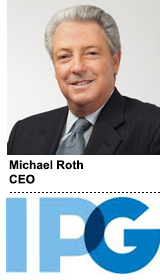Holding companies are being bludgeoned by the pandemic, and IPG is no exception.
Organic revenue decreased 9.9% in the quarter to $1.85 billion as clients cut back spend in response to the COVID-19 pandemic, the company said during its Q2 earnings call Wednesday.
IPG suffered declines in every major region, including the United States (-8%), the United Kingdom (-14.5%), continental Europe (-11%) Asia Pacific (-14%) and other markets (-14.7%).
“Our second quarter, as expected, bears the imprint of the pandemic and its economic impact,” said CEO Michael Roth, “and the most challenging global operating environment in memory.”
But impacts varied by client sector, and IPG’s exposure to the healthcare vertical was a lifeline. Healthcare companies make up more than a quarter of IPG’s client base, and their continued spend not only benefited its specialist healthcare agencies, but media, data and technology teams that won and retained large clients.
“The sector that has held up best to date despite the pandemic is healthcare,” Roth said. “We have significant operations in healthcare marketing.”
Technology, retail, telecom and food and beverage clients also fared relatively well in the quarter, while auto, transportation, financial services and industrials were hit hardest.
Digital media bore the most cut backs at the beginning of the quarter as clients rushed to pause campaigns. This activity dragged down growth in the media, data and technology group by high single digit percentage points. But Acxiom’s business “continued to hold up quite well” in the quarter, Roth said.
IPG’s creative agencies suffered declines in the mid-single digits to mid-teen percentages, while events, which makes up between 4% and 5% of the business, was most dramatically impacted in the quarter.
IPG’s new business pipeline is strong, but project-based work will likely be delayed as clients react to ongoing changes in the marketplace. The company did not provide guidance and is not yet sure if declines in the second half will continue to be worse than the first.
“The environment remains unclear for as long as COVID is a threat to everyday life,” Roth said. “Visibility to revenue remains challenging, and client decision-making difficult to forecast.”
WFH FTW
To minimize the impact of client cut backs, IPG has implemented layoffs, furloughs and salary decreases across all of its agencies.
The company also eliminated 500,000 square feet of office space permanently to reduce expenses and “accommodate a greater role for work-from-home, in a hybrid office-home model, in a post-COVID world,” Roth said.
“There is no question that the use of the office will change in the future, and we’re taking advantage of it,” Roth said. “These are permanent changes.”
Today, about 50% of IPG employees have returned to the office part-time in Asia, 30% to 40% have done so in Europe and only 10% have gone back to the office in the United States and United Kingdom.
IPG aims to realize $80 million to $90 million in savings due to cost-cutting measures, which will begin to show up in the third quarter. The holding company plans to implement additional cost-cutting plans in the second half of the year.
“When this does turn around, we will be lean, mean and in a position to continue to outperform our sector,” Roth said.















